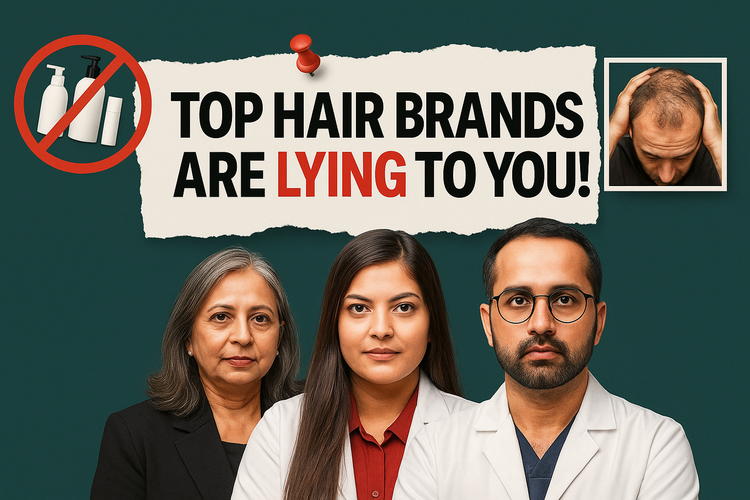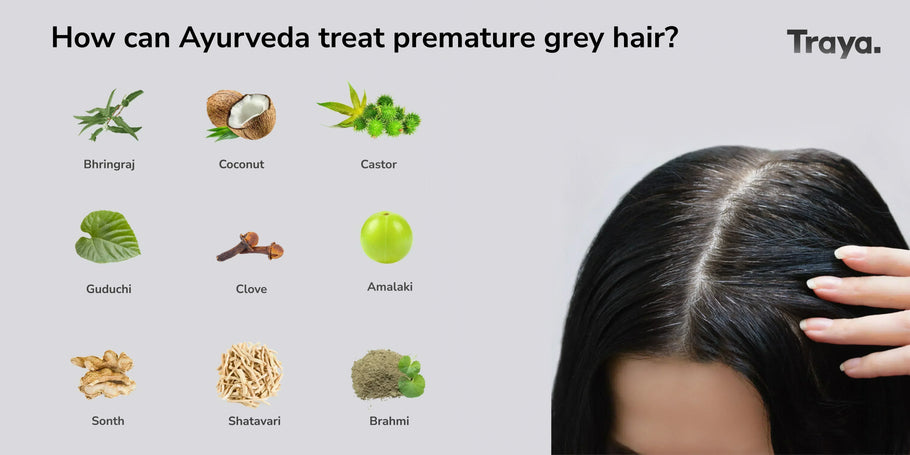Is Traya a Scam or a Science-Backed Brand?
When you hear a claim like “99% of users saw hair fall reduction,” your first reaction should be: “Wait, 99% of what?” That’s exactly the kind of misleading stat the industry often throws around and it’s time to break it down.
The Truth Behind the 99% Claims
"99% effective" sounds miraculous, right? But most of the time, these statistics refer to hair breakage, not root-level hair loss. That’s a key distinction.
-
Breakage is when hair snaps mid-shaft due to damage, dryness, or weak strands.
-
Hair loss is when the follicle shuts down, leading to thinning or bald patches.
Here’s how the trick works:
“They use non-conditioning shampoos in tests, so of course results look great.”
In these lab tests, a hair product is compared to a deliberately harsh shampoo one that lacks any conditioning agents. The test is set up to fail the control group, making even a mediocre product appear outstanding.
Lab Test Loopholes: How the Scam Works
-
Predefined Failures: Brands intentionally use non-conditioning shampoos in comparison tests.
-
Short-Term Metrics: Results are measured over 7–10 days long enough to show reduced breakage, but too short to assess regrowth.
-
Cherry-Picked Demographics: Participants with mild issues are chosen to show dramatic short-term improvement.
So, Is Traya a Scam?
No, Traya isn’t a scam. But it’s important to understand what makes them different.
Where other brands focus on shiny packaging, Traya starts with root-cause diagnosis:
“Traya doesn’t rely on such tests; we start with diagnosis.”
Traya uses:
-
Questionnaires tailored by trichologists
-
Optional blood tests (to detect thyroid issues, vitamin deficiencies, PCOS, etc.)
-
A team involving Ayurvedic doctors, nutritionists, and dermatologists
And unlike most brands, Traya includes disclaimers. They’re transparent about:
-
Timeframes (3–6 months for noticeable results)
-
Possible side effects
-
Need for compliance with treatment plans
Where most brands game the test, Traya gives the test. They don’t rely on a flashy serum alone they rely on a system.
What Makes Traya Legit?
|
Criteria |
Traya |
Typical Hair Brand |
|
Diagnosis-based approach |
Yes |
No |
|
Custom treatment plan |
Yes |
One-size-fits-all |
|
Backed by doctors |
Dermatologist + Ayurveda + Nutrition |
Often unclear “experts” |
|
Uses real lab testing? |
Optional blood tests |
Lab games on shampoos |
|
Honest disclaimers? |
Yes |
Rarely shown |
Traya doesn’t claim to cure all and that’s the strongest signal that it’s not a scam. Instead, it’s a science-backed system, even if results vary.
Hair Growth Serums That Actually Work: Minoxidil vs. Redensyl
This is where the hype gets real. Two of the most talked-about serums in the industry: Minoxidil and Redensyl.
If you’ve ever typed “hair growth serum that actually works” into Google, this is for you.
Minoxidil: Still the Gold Standard
Minoxidil is the only FDA-approved topical treatment for hair regrowth. Available in 2% and 5%, it improves blood circulation around follicles, waking dormant ones back to life.
“Minoxidil isn’t trendy it’s just proven. There’s no world where you don’t consider it for real regrowth.”
Redensyl: The Misunderstood Natural Contender
Redensyl is marketed as the “natural, safer alternative” to Minoxidil. But don’t get swept up by the green branding and gentle promises.
“The study compared Redensyl to 1% Minoxidil over 3 months that’s misleading.”
Why?
-
1% Minoxidil isn’t commonly prescribed (5% is the standard).
-
Three months is too short regrowth takes 4–6 months minimum.
-
Study sizes were small and not independently replicated.
Redensyl vs. Minoxidil: Real Talk
|
Feature |
Redensyl |
Minoxidil (5%) |
|
FDA Approved |
No |
Yes |
|
Time to Results |
3–6 months |
3–6 months |
|
Mode of Action |
Targets stem cells |
Increases blood flow |
|
Common Use |
Early thinning |
All stages |
|
Long-term Studies |
Lacking |
Strong history |
|
Side Effects |
Minimal |
Possible irritation |
|
Reversible Effects |
Unknown |
Reverses on stop |
What to Choose?
-
Early stages? Try Redensyl.
-
Visible thinning or bald spots? You need Minoxidil.
“Minoxidil is your chicken in biryani. Everything else is garnish. You can’t make biryani with just the garnish.”
Hair Growth Remedies: What Works, What’s a Myth
Hair care marketing thrives on the illusion of nature: onion juice, aloe vera, neem, bhringraj oil the list goes on. But what does science say?
Onion Juice: A Viral Remedy With Narrow Proof
“That onion juice study everyone talks about? It was done only in people with Alopecia Areata a rare autoimmune condition.”
-
The 2002 study tested onion juice on Alopecia Areata patients.
-
86.9% saw regrowth.
-
But it’s not the same as hormonal or genetic hair loss like MPB or FPHL.
-
There’s no evidence it helps those common types.
Yet brands still push “onion oil” because it sells, not because it works.
Aloe Vera, Neem & Herbal Oils: Feel-Good but Flimsy
“DIY helps you feel in control but that doesn’t mean it’s treating your actual condition.”
That emotional comfort is real. But real hair loss is often tied to hormones, thyroid, stress, or nutrition not surface-level remedies.
Ayurveda ≠ Herbal ≠ Scientifically Proven
-
Ayurveda is a complete medical system, not just plant-based oils.
-
Just because something is “Ayurvedic” doesn’t mean it’s scientifically dosed.
-
Many oils use “goodness of neem” in trace amounts, far below any therapeutic level.
Buzzword Glossary: What They Really Mean
|
Term |
Reality |
|
"Clinically Tested" |
Someone, somewhere, ran a test. Doesn’t mean it worked. |
|
"Dermatologist Approved" |
Could be one doctor. Not FDA-level validation. |
|
"Infused with Natural Goodness" |
Marketing spin. Often unmeasurable quantities. |
Are all natural remedies useless? No. Some can soothe or strengthen. But nourishing a dying follicle ≠ regrowing it. That takes stronger interventions.
How Brands Trick You with Tests, Claims & Packaging
One of the biggest industry secrets? Brands choose the claim first, then build the product.
“The 99% number? That was the marketing brief. The product was reverse-engineered to fit that narrative.”
The Claim Game: Here’s How It Works
-
Pick an easy-to-game metric: “breakage reduction”
-
Use a terrible control: harsh, non-conditioning shampoo
-
Run a short trial: 7–10 days
-
Report: “99% less breakage compared to baseline”
“Tests done on non-conditioning shampoo a loophole.”
It’s like testing an energy drink against being dehydrated. Of course anything looks effective in that context.
Packaging Psychology
-
Medical Fonts: Serif + pale blue = trust
-
Minimalism: Clean = effective (not always true)
-
Jargon: “Clinically proven peptide complex” sounds scientific but is often marketing spin
The trick?
-
“99%” = attention
-
“Natural” = trust
-
“Backed by science” = credibility
But none of this is regulated. These phrases hit your Insta feed before any verification.
So always ask: Compared to what? For how long? In whom?
What Should You Use? The Real Science Behind Hair Treatments
So what actually works?
Let’s Categorize by Hair Loss Stage
|
Hair Loss Stage |
Best Treatment Strategy |
|
Stage 1 (early thinning) |
Redensyl, Biotin, Scalp serums, Nutrition |
|
Stage 2–3 (visible thinning) |
Minoxidil 5%, Finasteride, Dermatologist consult |
|
Stage 4+ (advanced balding) |
Hair transplant, Minoxidil + Finasteride, PRP |
“You don’t treat baldness with feel-good ingredients. That’s malpractice.”
Your shampoo, onion oil, or neem serum? They may support scalp health. But not regrowth.
“Minoxidil is your chicken in chicken biryani. Everything else is garnish.”




